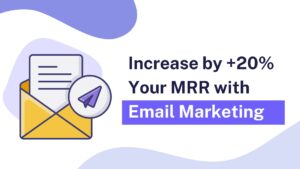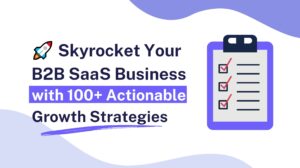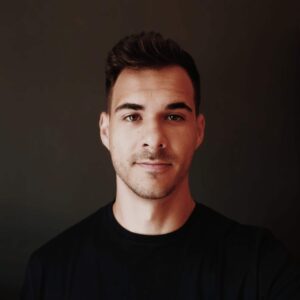Table of Contents
Navigating the startup landscape can be complex, particularly when dealing with B2B solutions. Understanding your audience, crafting effective strategies, and ensuring optimal budget utilization are all integral parts of this process. They’re essential to learning how to get B2B leads. This guide will systematically walk you through these steps.
The Reality of Startups Offering B2B Solutions
There are so many companies out there.
Each day 137,000 startups are born and 61% of them offer B2B solutions.
If you didn’t know this data, you are probably shocked.
Businesses are overwhelmed about all the solutions that appear in front of them in their social media or email inbox, trying to get them to sign up to their new tool.
So, what can we do?
Be different. Make them trust you first by solving their problems and don’t charge a thing.
Just focus on offering value in exchange for a lead. Don’t waste your money in traffic or branding campaigns. Promote value.
“You don’t need traffic, you need leads”
The Step-By-Step Guide to Gaining Quality B2B Leads
Gaining quality B2B leads involves several crucial steps, each of which will be explained in detail in the sections below.
Step 1: Identify and focus on Your Target Customer
Before you start creating ad campaigns, it’s essential to identify who your target customer is. What you need to know:
- Who: Job position / title
- What: Services they provide
- Why: Day-to-day problems
- How: Which platform do they use
Armed with this knowledge, you can tailor your content and marketing strategy to reach your target audience in the most effective way.
Step 2: Set Measurable Objectives
Reverse engineering your objectives is a critical step in setting up your business and marketing goals. This involves working backwards from your desired outcome to identify the specific steps and resources needed to achieve it. Here’s a more detailed breakdown of how you can reverse engineer your objectives:
- How much do you want to get?
- How many clients do you need?
- What should be your cost per client?
- What’s your budget? Is it enough?
- How many sales calls do you need to close a client?
- How many demo bookings?
- How many leads?
Create a strategy plan with a specific budget, timeframe, and conversion rates. This includes details about the number of sales calls and demo bookings required, and the number of leads you aim to generate.
Step 3: Choose an Effective Strategy
Different scenarios call for different strategies. These strategies depend on factors like your product/service, the level of competition, and problem awareness/urgency.
Strategy for Low Awareness / Few Competitors
“Become their top of mind“
- Create a valuable document.
- Design a lead magnet that solves a painful problem for your audience and that is related to your service.
- Build a list of your audience day-to-day problems.
- Just solve one problem on each lead magnet and test which one performs better.
- Some lead magnet ideas: case studies, checklist, guides, training, …
- Build an audience.
- Create ads campaigns offering the lead magnet in exchange of their email to grow your email list with Marketing Qualified Leads (leads that are your target audience). You can segment them to improve your content based on their interests.
- Platform: Meta Ads, Linkedin Ads, Tik Tok, Youtube…
- Topics: create valuable content solving your target audience problems that you already researched.
- Nurture them.
use an email sequence and provide value and help move the customer through the funnel.
- Followup time: each product / service would require less or more content to convince and convert them.
- Content: Practical tips, use cases, case studies, related news, demonstrations, …
- Don’t forget to add a call to action to schedule a call!
- Convert them into calls.
- Offer them: demonstration calls, discounts, configuration support, training, …
- Be creative in which channels you can use: newsletter, social ads, display ads, blog content, etc
Strategy for High Awareness / Many Competitors
“Meet the demand“
- Use search engine ads like google ads, bing ads or youtube.
Start by finding your “sniper keyword,” the most relevant keyword that defines your product or service and is the most searched.
Find long tail keywords related to your “sniper keyword” with at least 100 searches per month but have medium or low competition level.
Group them by topic, so you can create more relevant ads for them and bite your competitors that are just in general keywords. The more specific, the more google will help you. - Drive them to a landing page.
Test different LPs and call to actions like sign up for a free trial, free consultation, quote request or a special offer.
Ask for the obvious contact information you need and some qualification questions like: size of the company, job title, website or if they currently use a service/product similar to the one you provide. This will help your sales team prepare to the meeting or discard them. - Contact them as soon as possible …
Step 4: Budget Setup
Setting up your budget doesn’t mean that you will spend it all in the ads. You should start slow and test. After checking what it is bringing you results, you can scale the budget to bring more leads to your startup. Here are some examples of what you should invest for each platform to start getting results:
- Meta Ads: from $50 – $100 USD per day
- Google Ads: from $20- $60 USD per day
- TikTok Ads: $60 – $150 USD per day
- YouTube Ads: $40- $70 USD per day
- Linkedin: $70 to $160 USD per day
If your budget it’s tight, choose wisely the platform you are going to use.
Step 5: Tracking and Measuring Performance
Setup your KPIs (Key Performance Indicators) to know how your campaigns are performing. Track your main conversions as well.
Here are some examples of main KPIs:
- Cost per Purchase/Client
- Cost per Democall
- Cost per Lead
- Conversion rate (conversions / landing page visitors)
- Click Through Rate (CTR): link clicks / impressions
- Cost per click
Use google tag manager and google analytics to know exactly how many conversions you had, where did they come from and who are the people interested in your product / service.
Main Conversions are:
- Purchases / Sales / Clients
- Demo-bookings
- Leads
Step 6: Optimize your ads
After tracking all conversions relevant to your business, you can now optimize your ad campaigns. You need to set some rules of what is and what is not profitable and do A/B testing as much as you can to improve your conversions and then your sales. Here’s a deeper look at how to do it:
- Set Clear Metrics for Success: Establish key performance indicators (KPIs) such as cost per purchase, cost per lead, conversion rate, click-through rate (CTR), and cost per click to measure ad performance effectively.
- Conduct Regular A/B Testing: Implement A/B tests to compare two versions of an ad and determine which performs better. This may involve varying headlines, body copy, images, or calls to action.
- Continually Track and Analyze Performance: Utilize tools like Google Tag Manager and Google Analytics to keep track of your ad campaigns. They provide essential data about your conversions and their sources, as well as insights into who’s interested in your product/service.
- Make Necessary Adjustments: Based on the data gathered, adjust your ad strategy. This might include altering ad designs or messages, fine-tuning your targeting, or reallocating your budget. Keep in mind that optimization is an ongoing process that demands consistent attention.
- Implement Rules for Profitability: Establish clear profitability benchmarks for your campaigns. If an ad isn’t profitable, consider pausing it or making substantial changes to improve performance.
- Optimize for Sales, Not Just Leads: While generating leads is vital, the end goal is to convert these leads into sales. Ensure your optimization efforts encompass the entire sales funnel. Assess metrics like cost per sale and return on ad spend for a more comprehensive view of your ad’s impact.
Final thoughts
Today’s advertising is not as easy as it was but you can manage to make your campaigns and startup profitable. Choose the right strategy, the right platform. measure your performance and focus on improving your results.
IF YOU:
- Think this is too complicated
- Don’t have enough time to do it properly
- Or you prefer to rely on an expert to start getting B2B leads for your business…
Book a 15 min free consultation to go through your ad strategy >>







